The development of a corporate strategy should amount to more than the aggregation of business unit strategies. The best corporate strategies, in our experience, force a multibusiness company to make clear choices about its portfolio and the allocation of its resources. Yet the results of a recent McKinsey survey show that just one executive out of five says his or her corporation fully addresses strategy in this way. What’s more, more than a quarter of executives at multibusiness companies say their corporations lack a consistent process for developing strategy.
In this survey,1 we asked executives at multibusiness companies how they approach the development of corporate strategy—the frequency with which they review it and the amount of time they spend on it, the inputs of the process and the resulting activities, the barriers to reallocating resources, and the talent and other management processes they apply to overcome these barriers.
A small group of 151 respondents emerged who rate their companies’ approaches to strategy development as very effective and also say their profit margins are higher than those of competitors. Executives at companies that are “effective developers of strategy” are twice as likely as their peers to say their companies apply a distinct corporate strategy process (38 percent compared with 18 percent of all other respondents). Furthermore, 97 percent of these respondents view their companies’ processes for developing corporate strategy as consistent, compared with 59 percent of others. Executives also say these companies spend more time developing strategy, review strategies more frequently, and are much better at eliminating barriers to implementation.
Slow and steady doesn’t win
In both the boom of the mid-2000s and the financial crisis that followed, many companies did not (or could not) make critical portfolio choices and trade-offs. This may be why so few—just 19 percent of all respondents to this survey—say their companies have a distinct process for developing corporate strategy (Exhibit 1). Nearly a quarter, however, think their companies should engage in corporate strategy development on an ongoing basis (as opposed to episodically), compared with only 8 percent who say they currently do so (Exhibit 2). The small group of respondents at the effective-developer companies is ahead of the pack: 19 percent say their companies currently review corporate strategy on an ongoing basis.
A similar pattern emerges with regard to the amount of time a company’s senior-executive team actually spends—and ideally should spend—on developing corporate strategy in a typical year. No more than one in seven respondents say their companies’ senior leaders currently spend more than 15 percent of their time on this activity, but nearly three times as many describe that as the ideal time commitment. Among respondents at effective developers, a quarter say senior leaders currently spend more than 15 percent of their time on corporate strategy development.
Developing a distinct strategy
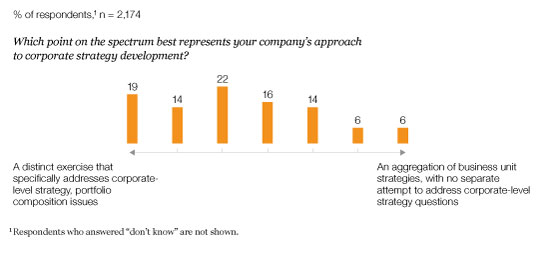
Few revisit strategy regularly
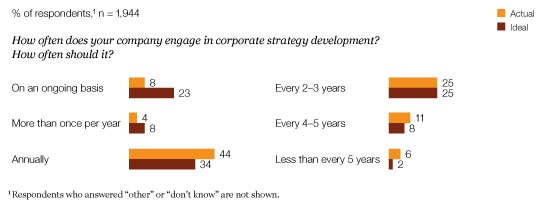
What goes into strategy
Financial projections are important for allocating capital to businesses in the existing portfolio. But the importance of trend analysis grows when it comes to adding corporate value by creatively reallocating resources and by changing its composition through mergers, acquisitions, and divestments.
Yet executives rank financials as their companies’ most important input when developing corporate strategy—23 percent of all respondents rank it first, followed by the performance of the overall portfolio, which 21 percent of all respondents rank first. Interestingly, executives at effective developers rank financial projections lower and macrolevel trends significantly higher (Exhibit 3). Furthermore, when asked what triggers a review of corporate strategy, more respondents say the trigger is their internal planning cycle rather than any external event, regardless of whether they work at effective companies or not.
Prioritizing financials, macrotrends
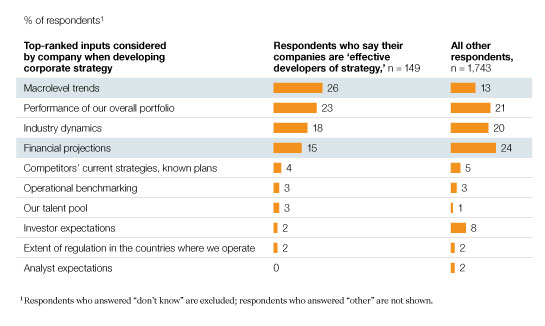
Implementing strategy
Frustration about implementing strategy is evident among almost all respondents. For example, 40 percent say that ideally, their companies should fully engage in making major shifts in talent across the portfolio—five times as many as those who say their companies currently do so (Exhibit 4).
The most striking contrast we found between most executives and those at effective-developer companies is the latter group’s apparent success at dismantling barriers to the implemen-tation of corporate strategies. For example, when asked which barriers (such as risk-averse decision makers) interfere with reallocation of their companies’ resources, 32 percent of the effective-developers group claim to have no barriers, while only 11 percent of others say the same (Exhibit 5). Similarly, 38 percent of respondents at effective developers say their companies face no barriers of any kind to implementing strategy, compared with only 7 percent of others.
The secret of effective developers’ success may be the extent to which they integrate their corporate strategy processes with key management processes. For example, 49 percent of respondents at effective developers, compared with 22 percent of others, say their corporate strategy processes are fully integrated with the approval and allocation of capital expenditures. As for talent development and assignment, 31 percent of effectives, but only 6 percent of others, integrate it (Exhibit 6).
Indeed, 60 percent of executives at effective companies say their companies are extremely effective at translating corporate strategies into day-to-day implementation. Just 6 percent of others say the same.
Dissatisfaction with status quo
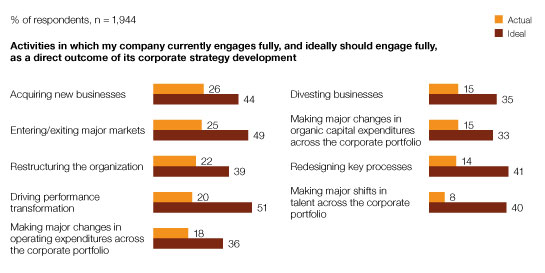
Effective companies face fewer barriers
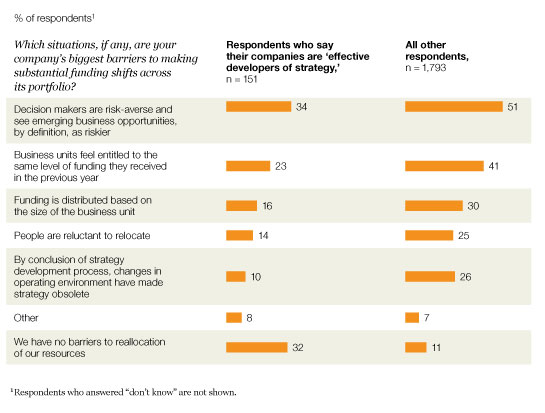
Better strategy through integration
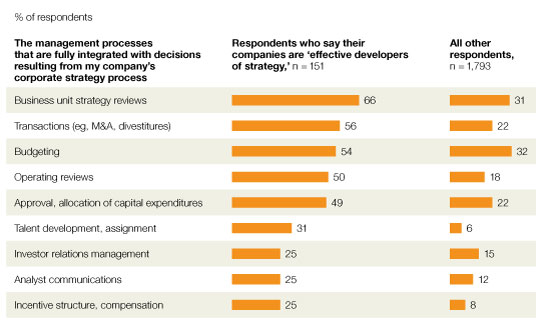
Looking ahead
Many corporations have emerged from the hunker-down mentality of the financial crisis with strong balance sheets and profits. Robust corporate strategy development will be essential to charting a future path to successful growth and returns.
Companies would do well to design an ongoing corporate strategy-development process that explicitly tackles key corporate-level issues, such as resource reallocation, and that drives on major economic trends and other external factors.
Managers should forge much stronger links between corporate strategy and other key management processes, such as talent management and allocation of capital expenditures, to ensure that their strategies translate into meaningful action.


